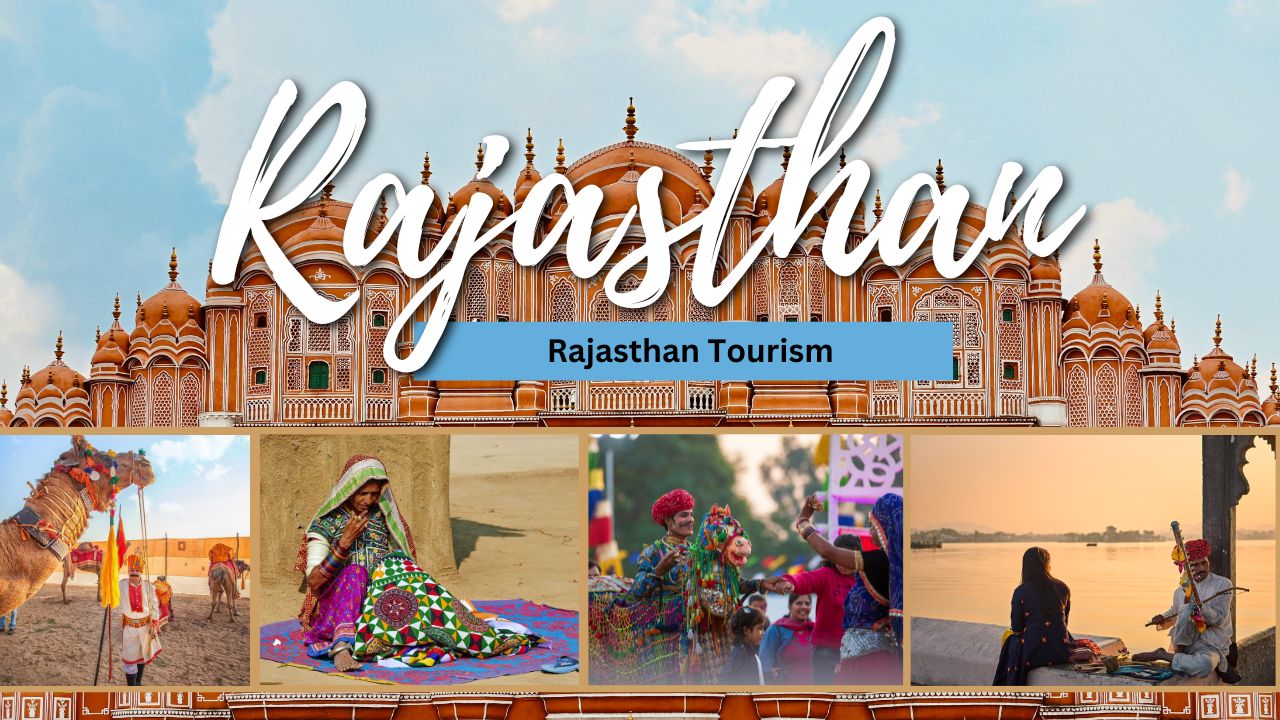Timeless Culture and Royal Charm of Rajasthan Tourism
Introduction to Rajasthan Tourism: A Land Like No Other
Rajasthan Tourism offers an experience shaped by grand palaces, golden deserts, and centuries-old traditions. This northwestern state of India stands as a proud reminder of India’s rich heritage, offering visitors a chance to immerse themselves in architectural marvels, local culture, and stories of valor and royalty. Whether you’re walking through the lanes of Jaipur or admiring the sand dunes of Jaisalmer, every part of Rajasthan has its own character and rhythm.
The Allure of Jaipur: Where Colors and Culture Meet
Jaipur, also known as the Pink City, is one of the most prominent highlights of Rajasthan Tourism. From the iconic Hawa Mahal to the majestic Amber Fort, Jaipur is full of landmarks that reflect the state’s regal history. The city’s markets, full of handcrafted jewelry, block-printed textiles, and traditional Rajasthani attire, attract travelers from across the globe.
Key spots include:
- City Palace: A blend of Rajput and Mughal architecture.
- Jantar Mantar: An astronomical observatory and UNESCO World Heritage Site.
- Jal Mahal: A palace situated in the middle of Man Sagar Lake.
Local dishes like dal baati churma and gatte ki sabzi offer a rich taste of Rajasthani cuisine, completing the cultural journey.
Udaipur: Lakes, Palaces, and a Royal Atmosphere
Udaipur is often called the City of Lakes, and it’s one of the most romantic destinations in India. Rajasthan Tourism presents Udaipur as a city where heritage hotels and historic palaces overlook calm, reflective waters.
Highlights of Udaipur include:
- Lake Pichola: Boat rides here give you views of the Lake Palace and City Palace.
- City Palace: Overlooking the lake, it is a vast complex with courtyards and museums.
- Sajjangarh Monsoon Palace: Offers panoramic views of the city and surrounding hills.
Udaipur is known for its serene ambiance and artistic beauty, making it a top destination for weddings and photography lovers.
Jodhpur: The Blue City with Majestic Forts
Known as the Blue City, Jodhpur is another essential part of Rajasthan Tourism. Houses painted in blue near Mehrangarh Fort give the city its unique visual identity. The massive fort, sitting on a rocky hill, dominates the cityscape and tells stories of historical battles and royal life.
Must-visit sites:
- Mehrangarh Fort: One of the largest forts in India, with well-preserved palaces and museums.
- Jaswant Thada: A marble cenotaph offering peaceful gardens and royal memorials.
- Umaid Bhawan Palace: Part palace, part hotel, and part museum.
The traditional attire and warm hospitality of Jodhpur add a personal touch to every visitor’s experience.
Jaisalmer: Golden Sands and Living Heritage
Jaisalmer is the heart of desert tourism within Rajasthan Tourism. The golden hue of its sandstone buildings and the Thar Desert’s endless dunes create an unforgettable setting.
Main attractions include:
- Jaisalmer Fort: A living fort with homes, shops, and temples inside its walls.
- Sam Sand Dunes: Ideal for camel rides and desert camping under starry skies.
- Patwon Ki Haveli: A cluster of five havelis showcasing intricate carvings and old-world charm.
Rajasthan Tourism in Jaisalmer often centers around cultural festivals, folk dances, and camel processions that bring the desert to life.
Bikaner: Desert Culture and Royal Legacy
Bikaner, though less commercialized, is rich in architectural beauty and cultural traditions. Known for its camel breeding farms and spicy snacks, Bikaner is a quieter yet deeply rooted part of Rajasthan Tourism.
Top spots to explore:
- Junagarh Fort: Built in the 16th century with stunning stone carvings and interiors.
- Karni Mata Temple: Famous for its resident rats, considered sacred.
- Camel Research Centre: Offers insights into camel rearing and desert adaptation.
Bikaner’s local sweets and fairs make it a fascinating stop on the Rajasthan Tourism map.
Pushkar: Spiritual Energy and Vibrant Traditions
Pushkar is a sacred town known for its holy lake and temples. It is also globally recognized for the Pushkar Camel Fair, making it a vibrant destination under Rajasthan Tourism.
Key attractions:
- Pushkar Lake: Surrounded by ghats and temples.
- Brahma Temple: One of the few temples dedicated to Lord Brahma.
- Pushkar Fair: A grand event with cultural performances, animal trading, and competitions.
This blend of spirituality and local life gives Pushkar a unique position in Rajasthan Tourism.
Mount Abu: The Only Hill Station of Rajasthan
Mount Abu stands apart in Rajasthan Tourism as the state’s only hill station. With cooler weather, green landscapes, and historic temples, it offers a different dimension to travelers.
Notable destinations:
- Dilwara Temples: Known for detailed marble carvings and Jain architecture.
- Nakki Lake: A pleasant spot for boating and picnics.
- Guru Shikhar: The highest peak in Rajasthan with panoramic views.
Mount Abu provides a welcome break from the desert terrain and offers peace for nature lovers and pilgrims alike.
Chittorgarh: Forts That Echo the Past
Chittorgarh, known for its grand fort and tales of sacrifice, holds an important place in Rajasthan Tourism. The stories of Rani Padmini and Rajput valor continue to resonate within the fort walls.
Highlights include:
- Chittorgarh Fort: A UNESCO World Heritage Site spread across 700 acres.
- Vijay Stambh (Victory Tower): Symbol of triumph and Rajput pride.
- Kirti Stambh: Dedicated to Jain heritage and faith.
The historical narratives make Chittorgarh a deeply emotional and educational experience for those interested in India’s past.
Local Culture: What Makes Rajasthan Tourism Unique
The heartbeat of Rajasthan Tourism lies in its culture. From colorful turbans to ghagras, traditional music to folk dances, every region adds its flavor to the state’s collective identity.
Rajasthan’s cultural highlights:
- Ghoomar and Kalbeliya dance performances.
- Puppet shows and folk storytelling traditions.
- Handicrafts such as mirror work, blue pottery, and camel leather goods.
Markets across Rajasthan are treasure troves of art and craftsmanship, offering visitors both souvenirs and stories.
Cuisine of Rajasthan: A Journey Through Flavors
Food plays a major role in Rajasthan Tourism. The state’s cuisine is influenced by its geography—scarce water, dry spices, and ingredients that last long.
Famous dishes include:
- Dal Baati Churma: A staple meal symbolizing Rajasthani hospitality.
- Laal Maas: A fiery meat curry that represents the warrior culture.
- Ker Sangri: A desert vegetable mix, both tangy and flavorful.
Every meal in Rajasthan is a reflection of resilience, tradition, and celebration.
Fairs and Festivals: The Celebratory Spirit of Rajasthan
Rajasthan Tourism is incomplete without mentioning its festivals. These events reflect the spirit of the land—bright, intense, and rooted in tradition.
Notable events:
- Desert Festival in Jaisalmer: Showcasing camel parades, folk music, and traditional competitions.
- Teej and Gangaur in Jaipur: Celebrated with processions and rituals.
- Bikaner Camel Festival: Celebrating the ship of the desert with unique performances.
Attending any of these events gives travelers a closer look into the joy and rituals of local life.
Transportation and Travel Tips for Rajasthan Tourism
Reaching and navigating Rajasthan is convenient, with airports in cities like Jaipur, Udaipur, and Jodhpur. Trains and well-connected roads make it easy to move between destinations.
Tips for travelers:
- Best time to visit: October to March for pleasant weather.
- Dress modestly, especially when visiting temples or rural areas.
- Carry cash for small purchases, especially in markets and rural regions.
Proper planning ensures that the journey across Rajasthan is smooth and enjoyable.
Final Thoughts on Rajasthan Tourism
Rajasthan Tourism is more than a journey through palaces and deserts—it’s a walk through living history, art, and traditions that are still thriving today. Every city, fort, and festival is a chapter in the larger story of India’s royal heartland. For anyone seeking authenticity, warmth, and timeless beauty, Rajasthan remains one of India’s most memorable destinations.













